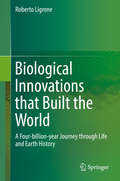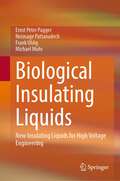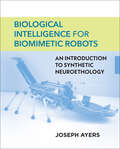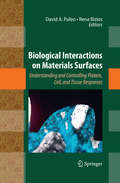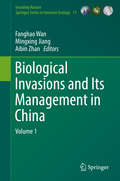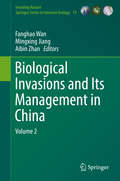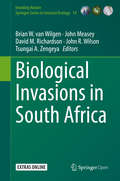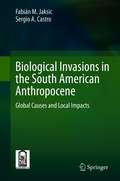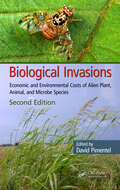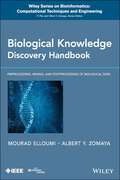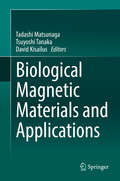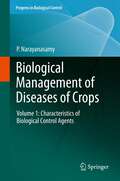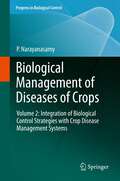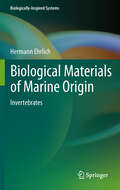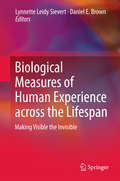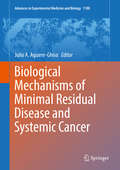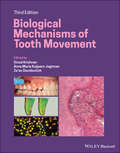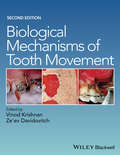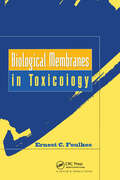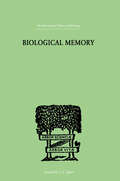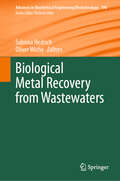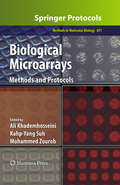- Table View
- List View
Biological Innovations that Built the World: A Four-billion-year Journey through Life and Earth History
by Roberto LigroneThe book is a detailed account of major biological events that contributed to create the present world and our species, with emphasis on cause-effect interrelationships and environmental impact. Its main goal is to guide the reader toward an understanding of the continuity of life across diversity, and of its large-scale interactions with the planet. Combining scientific soundness with a constant effort for clarity, the book begins with a cloud of dust in a corner of the Galaxy and, covering an immense lapse of time, terminates with an organism that ponders about the texture of the Universe. Comprehensive, updated references added to each chapter will help the reader wishing to expand any of the topics. A glossary explains less common technical terms.
Biological Insulating Liquids: New Insulating Liquids for High Voltage Engineering
by Frank Uhlig Ernst Peter Pagger Norasage Pattanadech Michael MuhrThis book describes the state-of-the-art use of biological insulating liquids in detail. In recent years, more and more transformers filled with esters have been put into operation. This is because people recognize the benefits of ester liquids in terms of their fire safety (high flash and fire points) and environmental characteristics, judging from their biodegradability, their low CO2 footprint (only valid for natural ester) and their beneficial interactions with solid insulation, etc. One of the main reasons is that the water adsorption and absorption characteristics of these liquids are excellent and very different compared to mineral oil. The today’s discussion about climate change and global warming is an additional driver for using natural ester. Another advantage is that transformers filled with biological insulating liquids can operate with an overload of up to 150%. This is advantageous in the case of volatile energy generation from wind and solar power and in the supply of electrical energy for electromobility. Liquid inside electrical equipment is the lifeblood that serves both as a dielectric and a cooling medium. Some properties of these liquids differ from mineral oil, which had to be considered in the transformer design. The dielectric liquid is always in direct contact with transformer materials; therefore, the interaction should be very well understood, especially when retrofilling an existing mineral oil filled device. There are several natural ester fluids derived from various seeds and fruits on the market, and their properties may differ more or less. In the book, the most important properties of the different biological insulating fluids and mineral oil are compared. Ester fluids have already found their way into various standards. The condition of the device can be verified very well from the contents of the insulating liquids. For analysis and testing, the same equipment and devices that are commonly used for mineral oil are used for ester liquid. The chemical and physical behaviors of ester fluids compared to mineral oil are different. This must always be considered when interpreting test results stemming from ester fluids. The book is a guideline for students, original equipment manufacturers, users, laboratories and authorities in the use of biological insulating liquids.
Biological Intelligence for Biomimetic Robots: An Introduction to Synthetic Neuroethology
by Joseph AyersAn introduction to how neuroethology can inform the development of robots controlled by synaptic networks instead of algorithms, from a pioneer in biorobotics.The trait most fundamental to the evolution of animals is the capability to adapt to novel circumstances in unpredictable environments. Recent advances in biomimetics have made it feasible to construct robots modeled on such unsupervised autonomous behavior, and animal models provide a library of existence proofs. Filling an important gap in the field, this introductory textbook illuminates how neurobiological principles can inform the development of robots that are controlled by synaptic networks, as opposed to algorithms. Joseph Ayers provides a comprehensive overview of the sensory and motor systems of a variety of model biological systems and shows how their behaviors may be implemented in artificial systems, such as biomimetic robots. Introduces the concept of biological intelligence as applied to robots, building a strategy for autonomy based on the neuroethology of simple animal modelsProvides a mechanistic physiological framework for the control of innate behaviorIllustrates how biomimetic vehicles can be operated in the field persistently and adaptivelyDeveloped by a pioneer in biorobotics with decades of teaching experienceProven in the classroom Suitable for professionals and researchers as well as undergraduate and graduate students in cognitive science and computer science
Biological Interactions on Materials Surfaces: Understanding and Controlling Protein, Cell, and Tissue Responses
by Rena Bizios David A. PuleoSuccess or failure of biomaterials, whether tissue engineered constructs, joint and dental implants, vascular grafts, or heart valves, depends on molecular-level events that determine subsequent responses of cells and tissues. This book presents the latest developments and state-of-the-art knowledge regarding protein, cell, and tissue interactions with both conventional and nanophase materials. Insight into these biomaterial surface interactions will play a critical role in further developments in fields such as tissue engineering, regenerative medicine, and biocompatibility of implanted materials and devices. With chapters written by leaders in their respective fields, this compendium will be the authoritative source of information for scientists, engineers, and medical researchers seeking not only to understand but also to control tissue-biomaterial interactions.
Biological Invasions and Animal Behaviour
by Weis Judith S. Daniel SolHow does behaviour affect biological invasions? Can it explain why some animals are such successful invaders? With contributions from experts in the field, and covering a broad range of animals, this book examines the role of behaviour in biological invasions from the point of view of both invaders and native species. The chapters cover theoretical aspects, particularly relevant behaviours and well-documented case studies, showing that behaviour is critical to the success, and ecological and socio-economic impact, of invasive species. Its insights suggest methods to prevent and mitigate those impacts, and offer unique opportunities to understand the adaptive role of behaviour. Offering a comprehensive overview of current understanding on the subject, the book is intended for biological invasion researchers and behavioural ecologists as well as ecologists and evolutionary biologists interested in how organisms deal with anthropogenic environmental changes such as climate change and habitat loss.
Biological Invasions and Its Management in China: Volume 1 (Invading Nature - Springer Series in Invasion Ecology #11)
by Fanghao Wan Mingxing Jiang Aibin ZhanThe book discusses invasive-species problems in agriculture, forests and aquatic ecosystems, highlighting the invasive mechanisms and management of the selected invasive species. Biological invasion has become a serious global ecological and economic problem that deserves particular attention from both government officials and scientists. This volume focuses on three key scientific areas: 1) population establishment and spreading mechanisms of the selected invasive species; 2) ecology adaptation, population growth, expansion and evolution of invasive species; and 3) impact of bio-invasion on the ecosystem structure and function at community and ecosystem levels. The presented research will result in techniques for better management of invasive species. Dr. Fanghao Wan is a professor at the Chinese Academy of Agricultural Sciences Institute of Plant Protection in Beijing, China. Dr. Mingxing Jiang is a professor at Zhejiang University's College of Agriculture and Biotechnology Institute of Insect Sciences in Hangzhou, China. Dr. Aibin Zhan is a researcher at the Center for Eco-Environmental Sciences (RCEES) at the Chinese Academy of Sciences (CAS), Beijing, China.
Biological Invasions and Its Management in China: Volume 2 (Invading Nature - Springer Series in Invasion Ecology #13)
by Fanghao Wan Mingxing Jiang Aibin ZhanThe book discusses invasive-species problems in agriculture, forests and aquatic ecosystems, highlighting the invasive mechanisms and management of the selected invasive species. Biological invasion has become a serious global ecological and economic problem that deserves particular attention from both government officials and scientists. This volume focuses on three key scientific areas: 1) population establishment and spreading mechanisms of the selected invasive species; 2) ecology adaptation, population growth, expansion and evolution of invasive species; and 3) impact of bio-invasion on the ecosystem structure and function at community and ecosystem levels. The presented research will result in techniques for better management of invasive species. Dr. Fanghao Wan is a professor at the Chinese Academy of Agricultural Sciences Institute of Plant Protection in Beijing, China. Dr. Mingxing Jiang is a professor at Zhejiang University's College of Agriculture and Biotechnology Institute of Insect Sciences in Hangzhou, China. Dr. Aibin Zhan is a researcher at the Center for Eco-Environmental Sciences (RCEES) at the Chinese Academy of Sciences (CAS), Beijing, China.
Biological Invasions in South Africa (Invading Nature - Springer Series in Invasion Ecology #14)
by David M. Richardson John R. Wilson Brian W. van Wilgen John Measey Tsungai A. ZengeyaThis open access volume presents a comprehensive account of all aspects of biological invasions in South Africa, where research has been conducted over more than three decades, and where bold initiatives have been implemented in attempts to control invasions and to reduce their ecological, economic and social effects. It covers a broad range of themes, including history, policy development and implementation, the status of invasions of animals and plants in terrestrial, marine and freshwater environments, the development of a robust ecological theory around biological invasions, the effectiveness of management interventions, and scenarios for the future. The South African situation stands out because of the remarkable diversity of the country, and the wide range of problems encountered in its varied ecosystems, which has resulted in a disproportionate investment into both research and management. The South African experience holds many lessons for other parts of the world, and this book should be of immense value to researchers, students, managers, and policy-makers who deal with biological invasions and ecosystem management and conservation in most other regions.
Biological Invasions in the South American Anthropocene: Global Causes and Local Impacts
by Fabián M. Jaksic Sergio A. CastroThis book provides a conceptually organized framework to understand the phenomenon of biological invasions at the Anthropocene global scale. Most advances toward that aim have been provided from North American and European researchers, with fewer contributions from Australia and South Africa. Here we fill the void from the Neotropics, focusing on the research experience in South American countries, with a strong emphasis on Argentina and Chile. The text is divided into two parts: The first half comprises self-contained chapters, providing a conceptual, bibliographic and empirical foundation in the field of invasion biology, from an Anthropocene perspective. The second half reviews the ecology, biogeography, and local impacts in South America of exotic species groups (European rabbit, Eurasian wild boar, Canadian beaver, North American mink, and Holarctic freshwater fishes), which are shown to be useful models for case studies of global relevance.
Biological Invasions: Economic and Environmental Costs of Alien Plant, Animal, and Microbe Species, Second Edition
by David PimentelThe impact of invasive species is second only to that of human population growth and associated activities as a cause of the loss of biodiversity throughout the world. In the United States, invasions of nonnative plants, animals, or microbes cause major environmental damage. The second edition of Biological Invasions: Economic and Environmental Cos
Biological Knowledge Discovery Handbook: Preprocessing, Mining and Postprocessing of Biological Data (Wiley Series in Bioinformatics #23)
by Mourad Elloumi Albert Y. ZomayaThe first comprehensive overview of preprocessing, mining, and postprocessing of biological data Molecular biology is undergoing exponential growth in both the volume and complexity of biological data—and knowledge discovery offers the capacity to automate complex search and data analysis tasks. This book presents a vast overview of the most recent developments on techniques and approaches in the field of biological knowledge discovery and data mining (KDD)—providing in-depth fundamental and technical field information on the most important topics encountered. Written by top experts, Biological Knowledge Discovery Handbook: Preprocessing, Mining, and Postprocessing of Biological Data covers the three main phases of knowledge discovery (data preprocessing, data processing—also known as data mining—and data postprocessing) and analyzes both verification systems and discovery systems. BIOLOGICAL DATA PREPROCESSING Part A: Biological Data Management Part B: Biological Data Modeling Part C: Biological Feature Extraction Part D Biological Feature Selection BIOLOGICAL DATA MINING Part E: Regression Analysis of Biological Data Part F Biological Data Clustering Part G: Biological Data Classification Part H: Association Rules Learning from Biological Data Part I: Text Mining and Application to Biological Data Part J: High-Performance Computing for Biological Data Mining Combining sound theory with practical applications in molecular biology, Biological Knowledge Discovery Handbook is ideal for courses in bioinformatics and biological KDD as well as for practitioners and professional researchers in computer science, life science, and mathematics.
Biological Magnetic Materials and Applications
by Tadashi Matsunaga Tsuyoshi Tanaka David KisailusThis book addresses the biologically controlled synthesis of magnetic materials, and its applications in bio-inspired design and synthesis. It highlights several key aspects of biologically produced magnetic materials – (i) organisms that biologically synthesize and utilize magnetic materials; (ii) formation mechanisms; (iii) how these biological formation routes yield various phases and morphologies; and (iv) the resultant magnetic and structural properties – and describes diverse bio-inspired approaches to utilizing magnetic materials in applications ranging from semiconductor to health industries.In addition, the book discusses the recent industrial use of magnetic materials to develop scalable technologies that encompass protein displays, drug-delivery, biophysical separations, and medical diagnostics, as well as outlining future next-generation applications. As such, it offers valuable insights for all scientists interested in using multidisciplinary fields to overcome current obstacles, and in gaining multifaceted expertise in magnetic materials bionanotechnology.
Biological Management of Diseases of Crops: Volume 1: Characteristics of Biological Control Agents (Progress in Biological Control #15)
by P. NarayanasamyBiological disease management tactics have emerged as potential alternative to chemical application for containing crop diseases. Biotic and abiotic biological control agents (BCAs) have been demonstrated to be effective against diseases caused by microbial plant pathogens. Combination of biotic and abiotic agents leads to synergism and consequent improvement in the effectiveness of disease control. It is essential to assay the biocontrol potential of all isolates/species of fungal, bacterial and viral biocontrol agents by different techniques in vitro and under greenhouse and field conditions and to precisely identify and differentiate the most effective isolates from less effective ones by employing biological, immunological and nucleic acid-based assays.
Biological Management of Diseases of Crops: Volume 2: Integration of Biological Control Strategies with Crop Disease Management Systems (Progress in Biological Control #16)
by P. NarayanasamyBiological management of diseases of crops is influenced by the nature of interactions between the pathogens and other organisms and the plants. Due to development of resistance in pathogens to fungicides and bactericides, determination of compatibility of biotic biocontrol agents with chemicals is essential for selecting strains of biocontrol agents (BCAs) showing resistance to chemicals to effectively restrict use of the chemicals. Microbial plant pathogens and the antagonists present in the soil and on the plant surfaces are influenced by various cultural practices. It is possible to reduce disease incidence and intensity by crop sanitation and using appropriate rotational crops. Application of physical techniques involving the use of heat, solarization and irradiation has potential to reduce the pathogen population or weaken the potential of pathogens present in the seed, planting materials and soil.
Biological Materials Science
by Marc André Meyers Po-Yu ChenTaking a unique materials science approach, this text introduces students to the basic concepts and applications of materials and biomedical engineering and prepares them for the challenges of the new interdisciplinary field of biomaterials science. Split into three sections - Basic Biology Principles, Biological Materials, and Bioinspired Materials and Biomimetics - it presents biological materials along with the structural and functional classification of biopolymers, bioelastomers, foams, and ceramic composites. More traditional biomimetic designs such as Velcro are then discussed in conjunction with new developments that mimic the structure of biological materials at the molecular level, mixing nanoscale with biomolecular designs. Bioinspired design of materials and structures is also covered. Focused presentations of biomaterials are presented throughout the text in succinct boxes, emphasising biomedical applications, whilst the basic principles of biology are explained, so no prior knowledge is required. The topics are supported by approximately 500 illustrations, solved problems, and end-of-chapter exercises.
Biological Materials of Marine Origin
by Hermann EhrlichThis is the second monograph by the author on biological materials of marine origin. The initial book is dedicated to the biological materials of marine invertebrates. This work is a source of modern knowledge on biomineralization, biomimetics and materials science with respect to marine vertebrates. For the first time in scientific literature the author gives the most coherent analysis of the nature, origin and evolution of biocomposites and biopolymers isolated from and observed in the broad variety of marine vertebrate organisms (fish, reptilian, birds and mammals) and within their unique hierarchically organized structural formations. There is a wealth of new and newly synthesized information, including dozens of previously unpublished images of unique marine creatures including extinct, extant and living taxa and their biocomposite-based structures from nano- to micro - and macroscale. This monograph reviews the most relevant advances in the marine biological materials research field, pointing out several approaches being introduced and explored by distinct modern laboratories.
Biological Materials of Marine Origin: Invertebrates (Biologically-Inspired Systems #1)
by Hermann EhrlichBiological substances appeared in marine environments at the dawn of evolution. At that moment, the ?rst organisms acquired the ability to synthesize polymer chains which were the basis, in their turn, for the formation of the building blocks that fueled the so-called self-assembling process. They, in their turn, produced more complicated structures. The phenomenon of three main organic structural and sc- folding polymers (chitin, cellulose, and collagen) probably determined the further development and evolution of bioorganic structures and, of course, the organisms themselves. Allthethreebiopolymers,notwithstandingtheirdifferencesinchemical composition, have the common principles in their organization: nano?brils with the diameter 1. 5–2 nm, the ability to self-assemble, production of ?brillar and ?ber-like structures with hierarchical organization from nano—up to macrolevels, the ability to perform both the role of scaffolds and the templates for biomineralization and formation of the rigid skeletal structures. Chitin and collagen in particular played the determining role in the formation of skeletal structure in marine invertebrate organisms. These two biopolymers possess all the qualities needed to refer to them simul- neously as biological materials and biomaterials, the latter thanks to their successful application in biomedicine. The fact that modern science ?nds chitin and collagen both in unicellular and in multicellular invertebrates in fossil and modern species con?rms beyond a doubt the success of these biological materials in the evolution of biological species during millions of years. I realize that this success should be consolidated at genetic level and the detection of corresponding conserved genes must be the main priority.
Biological Measures of Human Experience across the Lifespan: Making Visible the Invisible
by Daniel E. Brown Lynnette Leidy SievertThe proposed volume explores methods used by social scientists and human biologists to understand fundamental aspects of human experience. It is organized by stages of the human lifespan: beginnings, adulthood, and aging. Explored are particular kinds of experiences - including pain, stress, activity levels, sleep quality, memory, and menopausal hot flashes - that have traditionally relied upon self-reports, but are subject to inter-individual differences in self-awareness or culture-based expectations. The volume also examines other ways in which normally "invisible" phenomena can be made visible, such as the caloric content of foods, blood pressure, fecundity, growth, nutritional status, genotypes, and bone health. All of the chapters in this book address the means by which social scientists and human biologists measure subjective and objective experience.
Biological Mechanisms of Minimal Residual Disease and Systemic Cancer (Advances in Experimental Medicine and Biology #1100)
by Julio A. Aguirre-GhisoThis book focuses on the biological mechanisms of minimal residual disease (MRD) and recurrence. It integrates this biology in solid cancers and in hematological malignancies. It reports also on technological advancements for monitoring MRD, derived from mechanistic insights. Chapters in solid and hematological malignancies address stem cell biology, genetics, epigenetics and micro-environmental regulation of dormant MRD. Novel insight into technologies for molecular phenotyping of MRD and monitoring of CTCs, DTCs and cell free RNA and DNA are also addressed extensively. Five chapters explore the above concepts in solid cancers such as prostate, breast, melanoma, head and neck and esophageal. Two chapters also explore the basic mechanisms of vascular biology targeting and epigenetic mechanisms regulating pluripotency programs during dormancy. Similar biology is explored in hematological malignancies such as T-ALL, CML, AML and multiple myeloma in additional four chapters. This book is edited and prefaced by Dr. Julio Aguirre-Ghiso, an expert in dormancy and recurrence. The chapters are written by world-recognized experts Drs. Ravi Bahtia, Samir Parekh, Russel Taichman, Monica Guzman, David Hoon, Denis Schewe, Irmela Jeremias, Cyrus Ghajar, Maria Soledad Sosa and Nicholas Stoecklein. The topic of this book is of particular interest to both basic cancer cell biologists and physician scientists that are working to provide a more integrated view of the biology of MRD and to those interested in working on or learning about this paradigm. The integrated and cross-disciplinary focus of the book from biology to medicine seeks to help bridge gaps to improve cancer care and prevent recurrences.
Biological Mechanisms of Tooth Movement
by Vinod Krishnan Anne Marie Kuijpers?Jagtman Ze Ev DavidovitchThis new edition continues to be an authoritative reference to the scientific foundations underpinning clinical orthodontics The newly and thoroughly revised Third Edition of Biological Mechanisms of Tooth Movement delivers a comprehensive reference for orthodontic trainees and specialists. It is fully updated to include new chapters on personalized orthodontics as well as the inflammatory process occurring in the dental and paradental tissues. It is heavily illustrated throughout, making it easier for readers to understand and retain the information discussed within. The topics covered range from bone biology, the effects of mechanical loading on tissues and cells, genetics, tissue remodeling, and the effects of diet, drugs, and systemic diseases. The Third Edition of Biological Mechanisms of Tooth Movement features seven sections that cover subjects such as: The development of biological concepts in orthodontics, including the cellular and molecular biology behind orthodontic tooth movement Mechanics meets biology, including the effects of mechanical loading on hard and soft tissues and cells, and biological reactions to temporary anchorage devices Inflammation and orthodontics, including markers for tissue remodeling in the gingival crevicular fluid and saliva Personalized diagnosis and treatment based on genomic criteria, including the genetic influences on orthodontic tooth movement Rapid orthodontics, including methods to accelerate or decelerate orthodontic tooth movement Perfect for residents and PhD students of orthodontic and periodontal programs, Biological Mechanisms of Tooth Movement is also useful to academics, clinicians, bone biologists, and researchers with an interest in the mechanics and biology of tooth movement.
Biological Mechanisms of Tooth Movement
by Vinod Krishnan Ze'Ev DavidovitchBiological Mechanisms of Tooth Movement, Second Edition is an authoritative reference to the scientific foundations underpinning clinical orthodontics. Led by an expert editor team and with contributions from an international group of contributors, the book covers key topics including bone biology, the effects of mechanical loading on tissues and cells, genetics, inflammation, tissue remodeling and the effects of diet, drugs, and systemic diseases. Highly-illustrated throughout, this second edition has been fully revised, updated and expanded to new developments in genomics, rapid orthodontics and current controversies in tooth movement research. Trainees, qualified specialists and researchers in orthodontics can rely on this comprehensive text to inform them about the clinical and scientific implications of the biological mechanisms involved in the movement of teeth.
Biological Membranes in Toxicology
by E. C. FoulkesUsing this concise yet complete introduction to all aspects of biological membranes and their responses to toxicants, the reader will understand the role of cell membranes in controlling uptake, distribution, extrusion and excretion of toxic xenobiotics. The book also covers the historical background and critically evaluates some of the experimenta
Biological Memory
by Rignano, EugenioFirst published in 1999. Routledge is an imprint of Taylor & Francis, an informa company.
Biological Metal Recovery from Wastewaters (Advances in Biochemical Engineering/Biotechnology #190)
by Sabrina Hedrich Oliver WicheThis book reviews the latest research on innovative and sustainable biotechnologies for metal recovery from various process streams, emphasising the fundamentals and applications of biosystems. Divided into 7 chapters, it clarifies many topics including biological iron and aluminum recovery from wastewaters, precious metal recovery (Pt, Pd, Au, Ag), algal-based metal recovery, selenium and tellurium recovery, phytoextraction options, and arsenic removal by sulfate-reducing bacteria. Expert contributors explore microbial metabolisms such as iron oxidation, sulfate/sulfur reduction, and selenite reduction through the lens of environmental sustainability. In this book, readers will discover various case studies and commercial applications of these biotechnologies. Particular attention is given to combinations of biological systems with electrochemistry to enhance metal recycling from complex and diluted streams. This book is a valuable resource for researchers in the field of environmental biotechnology, and scholars of environmental science, chemical engineering and microbiology. Waste management and resource recovery professionals will benefit greatly from the insights provided. This book is a must-read for anyone interested in sustainable solutions for critical metal supply within a circular economy framework.
Biological Microarrays: Methods and Protocols (Methods in Molecular Biology #671)
by Mohammed Zourob Kahp-Yang Suh Ali KhademhosseiniRecent developments in microarray technology have changed the landscape of biology and biomedical research, and they have revolutionized RNA and DNA research. In Biological Microarrays: Methods and Protocols, expert researchers explore exciting new developments in the field, providing a comprehensive approach to biological microarrays that conveys not only the state-of-the-art fundamentals, but also includes applications of the most innovative methods. Chapters address both the application of biological microarrays, including DNA/RNA, apatmer, proteins, tissues, oligonucleotides, carbohydrates, biomaterials, cells, bacteria, and virus microarrays, and also explore the different techniques used for generating microarray platforms. Composed in the highly successful Methods in Molecular BiologyTM series format, each chapter contains a brief introduction, step-by-step methods, a list of necessary materials, and a Notes section which shares tips on troubleshooting and avoiding known pitfalls. Wide-ranging and revolutionary, Biological Microarrays: Methods and Protocols serves as a primary source for academics, practitioners, and professionals in related fields, including biologists, biotechnologists, biochemists, analytical chemists, and biomedical, physical, and microsystems engineers, to name a few, appealing to all of those interested in the present and future state of biological microarray research.
